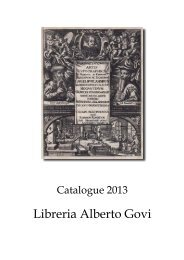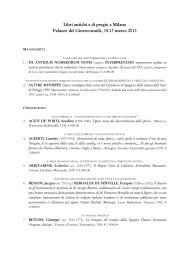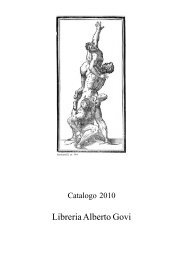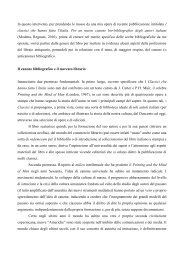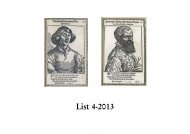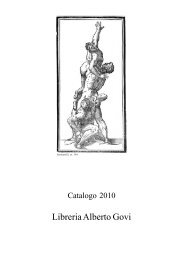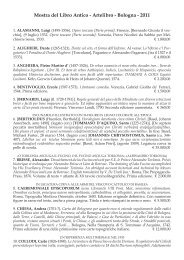Create successful ePaper yourself
Turn your PDF publications into a flip-book with our unique Google optimized e-Paper software.
to Rome by his early patron Cardinal Ludovisi, the latter having been elected pope.<br />
Guercino was charged with the decoration of the Loggia delle Benedizioni in Saint<br />
Peter’s, a vast undertaking that in the end came to nothing because of the premature<br />
death of the Pope (July 8, 1623). Nevertheless he received many important commissions,<br />
both private and ecclesiastical. Guercino returned then to Cento, where he remained<br />
until 1642. Although he was back in his native town, his fame was growing abroad. In<br />
1632 Maria de’ Medici, Queen Mother of France, was on the point of inviting him to<br />
the French court, when the idea had to be abandoned because of political troubles.<br />
With Guercino’s move to Bologna in 1642 to take up the mantle as the city’s leading<br />
painter, his work entered his final phase. At first he lived in the palace of Count Filippo<br />
Aldrovandi, and then he moved his studio to the house he bought, that later came to<br />
be known as the Casa Gennari (from the name of his heirs). The activity of Guercino’s<br />
last years remains hard to assess. Although he was acclaimed more than ever (in fact<br />
he produced painting for an international clientele including King Charles of England<br />
and was visited by Queen Christina of Sweden in 1655 on her way to Rome), he<br />
was beset by ill health and seems to have depended more and more on the help of<br />
his nephews, Benedetto and Cesare Gennari. Guercino died in 1666 in Bologna. He<br />
left an impressive legacy of nearly 400 paintings and well over 1,000 drawings that<br />
demonstrate his extraordinary power of invention (cf. M. Turner, ed., Guercino: la<br />
scuola, la maniera, i disegni agli Uffizi, Firenze, 2008, passim).<br />
P. Bagni, Il Guercino e i suoi incisori, Roma, 1988, pp. 6-7 (Gatti) and pp. 90-91 (Curti);<br />
G.G. Bertelà-S. Ferrara, Incisori Bolognesi ed Emiliani del secolo XVII, Bologna, 1973,<br />
nos. 653a-674 (Gatti) and nos. 499a-518a (Curti); F. Gozzi, Il Guercino, Le stampe della<br />
Pinacoteca civica [di Cento], Ferrara, 1996, pp. 13-14 (Gatti); J.T. Spike, The Illustrated<br />
Bartsch, New York, 1981, XLI, pp. 109-130, nos. 118-139 (Gatti); C.A. Petrucci, Catalogo



